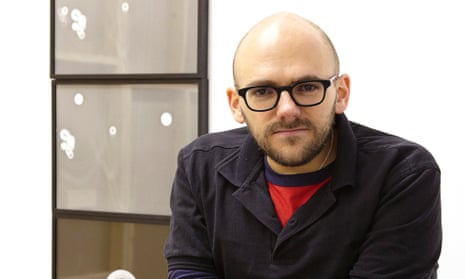At Art Basel, you can’t move for celebrities, art dealers and the super-rich, but the people whose work it depends on – the artists – are rather more scarce. Many prefer not to have to worry about the buying and selling of their work, or at least don’t want to see the hustling up close. British artist Ryan Gander, however, is made of sterner stuff.
“It riles me how artists can damn the commercial side of the art world when actually it’s the only thing that enables them to make work,” he says. “If you want to sell your work, you have to take your pig to the market. And if you want to make more work, you have to sell your pig.”
Besides, he says, Art Basel is “a place where you can come and see loads of art. Artists don’t send shit stuff to art fairs, so you come and see what they think is representational of their practice and is of quality. That’s interesting in itself. The second thing is that it’s in Miami and it’s really warm – how good is that?”
Coming from Cheshire in the north of England, as Gander does, you can see the attraction.
A conceptual artist, Gander has been commissioned by the fair’s Public section (in a park outside) to make two pieces. For the first, he hired two bodyguards to walk around with Public’s curator, Nicholas Baume, all day. “They’re not actors, they’re armed and they have radios. They help him get through the crowd and stand in the background when he gives interviews. I think he’s a little bit embarrassed. But I think that’s part of the point, to challenge him. It’s always the artists that have to do the hard bloody work, isn’t it?”
Miami Beach’s glitzy atmosphere makes it perfect for the work, says Gander. “It fits because of the ridiculous context of it being all flashing and beeping and million different colours, celeb central and everyone’s ‘Have you seen Jay Z?’ The bodyguard’s in that whole language of visibility – seeing and being seen. When you see the bodyguards walking around there’s an immediate change in the atmosphere around him because people think there’s a celebrity there. It’s a weird spatial dynamic.”
The other piece is a package stuck in a tree that contains the tools with which to make an artwork. Gander is amused that the fair has placed a sign underneath it instructing people to look up. “I thought it really said something about the quality of spectators in Miami that their eyes need directing.”
Drily funny both in his work and in person, Gander is simultaneously amused and appalled by the ostentation of the collectors and viewers at Art Basel. “It’s a very showy place,” he says. “I came out of a dinner last night and there was a gold Maserati, a Bentley, a Rolls Royce and a Porsche. They’re all cars that you wouldn’t want to drive – they’d make you look like a total dick. It’s weird as well because that showiness is also associated with taste, and that makes you worry a bit.”
Gander says that a new generation of collectors are favouring work he, borrowing a Frieze critic’s term, calls crapstraction – “art with things like stars, diamonds, palm trees, skulls, smileys, any emoticon. That’s what everyone seems to be interested in, daft cliches with no real meaning, depth, integrity or conceptual rigour.” Though he won’t name names on the record, there is work answering to that description at the Miami fair.
Building a meaningful art collection, says Gander, takes a lot more than money and a flair for social media. “Maybe it’s because with Instagram and everything, and everybody thinks they understand visual language, but do these people really have the knowledge and insight, and have they done the research to be able to build an intelligent collection, or are they just buying?” he says. “And you’ve got all these websites like ArtRank who say who’s going to go through the roof at Sotheby’s; and then there’s all these art advisers which are actually second-market dealers which is a totally new phenomenon. It really smells bad to me.”
It’s a world Gander has managed to avoid, though his clever, confusing interventions are a long way from the shiny baubles that attract a certain breed of oligarch – at Documenta, arguably the world’s most important art show, he exhibited a light breeze in an empty room. “My goal’s not to sell work, it’s to make art until I die,” he says. “I’m not like one of these flame artists, like kindling, where it burns very bright but it goes out quickly and there’s no heat off it. My goal is to burn like coal. No light, just a little glow, but really fucking hot for a really long time.” Long after, in fact, the trendy trinkets of Art Basel have been stashed, forgotten in a storage unit.

Comments (…)
Sign in or create your Guardian account to join the discussion